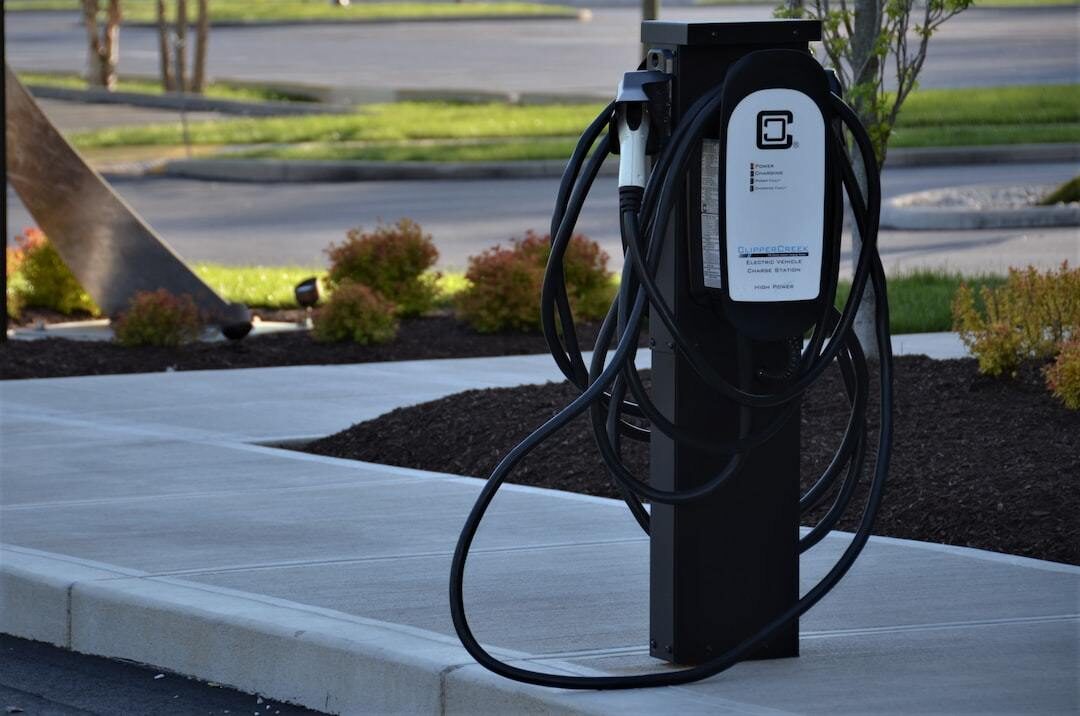Let’s dive straight into the heart of “how do i claim federal tax credit for ev charger”. It’s like finding a hidden treasure in your own backyard, one that not only boosts your green credentials but also sweetens the deal financially. In this piece, you’ll learn exactly what steps to take to snag that lucrative federal tax credit for installing an EV charger at home or for your business.
You’ll discover who’s eligible and how much you could save on both hardware and installation costs—up to $1,000 for residential properties and a staggering $100,000 per item for businesses under certain conditions. We’ll walk through the process step by step; from identifying qualifying equipment to filing Form 8911 with your income tax return.
But why stop there? Beyond federal incentives lie state rebates and utility company perks waiting to be claimed. By the end of this guide, maximizing savings on EV charging infrastructure will seem less like navigating a labyrinth and more like following a well-marked trail.
Understanding the Federal Tax Credit for EV Chargers
What is the Alternative Fuel Vehicle Refueling Property Credit?
The federal tax credit for electric vehicle (EV) chargers, officially known as the Alternative Fuel Vehicle Refueling Property Credit, might sound like a mouthful. But it’s actually your ticket to saving some green while going green. This nifty incentive lets homeowners and businesses get back 30% of their costs when they install an EV charging station, capping at $1,000 for residential setups.
This isn’t just about plugging in your car; it’s part of a bigger picture move towards clean energy solutions encouraged by Uncle Sam. Think of it as getting rewarded for helping reduce carbon footprints—one charger installation at a time.
The Impact on Homeowners and Businesses
If you’re thinking this sounds great but wonder if there’s fine print—there is, but it’s all pretty straightforward. For starters, not every Joe with an outlet qualifies. Your setup needs to meet specific construction requirements, which ensure that we’re moving towards more sustainable practices across the board.
Homeowners can breathe easier knowing they could shave off up to $1,000 from their bill come tax season thanks to installing one of these bad boys at home. On the flip side, businesses have even more reason to jump on board—they can snag up to $100K per item installed under certain conditions.
Step-by-Step Guide to Claiming Your EV Charger Tax Credit
To claim this credit without pulling out your hair or consulting a crystal ball: start with Form 8911—it’s your golden ticket here. This form is where you’ll spell out how much you spent on both purchasing and installing eligible charging equipment during the tax year in question.
Filing taxes might be right up there with watching paint dry in terms of excitement levels—but hey. The possibility of receiving cash back makes wading through paperwork worth it right? Just make sure everything’s wrapped up neatly before filing your federal income tax return so you don’t miss out because someone was too busy binge-watching shows instead of keeping receipts organized.
Additional Incentives Beyond Federal Tax Credits
You thought we were done? Nope. States like California are throwing extra goodies into the mix with rebates that sweeten the deal further. So, if you’re eyeing an eco-friendly ride, don’t miss out on these local incentives. They can make a big difference in your final decision. Check them out here.
Key Takeaway:
Save big on going green by getting a 30% tax credit for your EV charger install, with up to $1,000 for homes and $100K for businesses. Just use Form 8911 and keep those receipts tidy.
Eligibility Criteria for Claiming the EV Charger Tax Credit
Residential vs. Business Installations
Diving into the eligibility criteria for claiming the EV charger tax credit reveals a tale of two sectors: residential and business installations. Each comes with its own set of rules, but both are designed to push us towards a greener future.
For homeowners eager to join the electric vehicle revolution, there’s good news. The federal government offers a tax credit covering 30% of your total cost for purchasing and installing an EV charging station at your residence. However, don’t start planning on using that extra cash for a fancy dinner just yet; this incentive caps out at $1,000 per property item.
Businesses aren’t left out in the cold either. If you’re looking to install ev charging equipment at your commercial property or office space, you could be eligible for up to $100,000 per item under certain conditions detailed by IRS Form 8911. This is part of an effort not only to support businesses making eco-friendly choices but also build out essential infrastructure as more Americans make the switch to electric vehicles.
To get technical about what counts as “ev charging equipment,” we’re talking about any hardware used exclusively for providing electricity from alternative fuel sources (not including petroleum) directly into an electric vehicle—effectively turning it into your personal refueling station minus fossil fuels.
The distinctions between residential and business installations go beyond just how much money you can save—they touch upon installation processes too. While home setups typically involve standard electrical systems compatible with most modern homes, commercial projects might require significant upgrades or even new construction requirements based on local building codes or specific charger network configurations desired by businesses aiming at large-scale deployments.
This bifurcation underscores not only differing needs across sectors but reflects broader strategies aimed at encouraging widespread adoption of clean energy solutions through financial incentives—a win-win scenario when considering benefits like reduced emissions and less dependence on oil imports long term.
To ensure that individuals know exactly which steps they need to follow to claim their respective credits, taxpayers must file Form 8911 with their federal income tax return detailing all expenses associated with the purchase and installation project. Whether embarking upon the journey as a homeowner seeking to contribute toward a cleaner environment while enjoying some savings along the way or an entrepreneur wanting to incorporate sustainable practices within operations, exploring the possibilities offered by these programs is well worth the investment of time and resources given the potential returns in terms of both environmental impact and bottom line gains over time.
Key Takeaway:
Homeowners and businesses can save big on EV charger installations with federal tax credits—up to $1,000 for homes and $100,000 for commercial properties. Just remember to file IRS Form 8911 detailing your costs.
Step-by-Step Guide to Claiming Your EV Charger Tax Credit
Understanding the Basics: What You Need to Know Before Filing
If you’ve recently installed an electric vehicle (EV) charger, congrats on taking a step towards clean energy. Now, let’s talk about how you can get some of that investment back through federal tax credits. Specifically, we’re focusing on Form 8911 and your income tax return.
The heart of this credit is the Alternative Fuel Vehicle Refueling Property Credit. It’s like the government giving you a high-five for choosing cleaner fuel options. For homeowners, it means covering 30% of both hardware and installation costs up to $1,000. Businesses have even more potential benefits with up to $100,000 per item available under certain conditions.
Before diving into paperwork land, make sure your charging station meets all necessary criteria set by Uncle Sam. This isn’t just any charger—it has to be for electric vehicles (sorry gas-guzzlers), plus specific construction requirements apply.
Filling Out Form 8911: The Nitty-Gritty Details
To officially claim your credit when filing taxes this year or next—whenever you did the install—you’ll need Form 8911 in hand. Don’t worry; it’s not as daunting as it sounds. You can find everything needed at the official IRS documentation page for claiming the EV charger tax credit. This form is where the magic happens; here’s where you show off those expenses from buying and setting up your eco-friendly chariot’s refueling spot.
In completing this form alongside your federal income tax return remember two things:
- Total Cost: Include every penny spent—not just on purchasing but also installing your shiny new charging equipment.
- Tax Liability: Understand that receiving cash back depends heavily on other factors affecting overall tax liability for the year—the higher yours is before credits like these are applied; potentially more significant returns await.
Leveraging Additional Incentives Beyond Federal Credits
Your journey doesn’t end with federal incentives. Many states throw their hats in the ring offering rebates or additional credits which could further reduce costs associated with EV chargers beyond what Uncle Sam offers alone—for example, California provides specific amounts based upon equipment type through its program details found at the California rebate program page.
This multifaceted approach ensures maximum savings, so exploring local utility company incentives too might uncover hidden gems making the project even more cost-effective than initially anticipated. Keeping eyes peeled broadens horizons and possibilities within the realm of fiscal responsibility paired with environmental stewardship. By diving deeper into available resources, you’re not just cutting costs; you’re also contributing to a greener planet. It’s a win-win that merits serious consideration.
Key Takeaway:
Claiming your EV charger tax credit is a win-win: save money and support clean energy. Just make sure your setup meets the criteria, fill out Form 8911 with all costs, and don’t forget to explore state and local incentives for even bigger savings.
Additional Incentives Beyond Federal Tax Credits
Finding ways to save on installing an EV charger doesn’t stop with the federal tax credit. Many states and utility companies throw extra goodies into the mix, offering rebates and incentives that can significantly reduce your costs.
State Rebates: A Goldmine of Savings
Dig a little deeper into what your state offers, and you might find some treasure. States like California are leading the charge (pun intended), providing specific amounts based on equipment type for electric vehicle charging stations. These rebates are over and above what you get from Uncle Sam, making it even more affordable to go green. The details vary widely from one state to another, so doing a bit of homework could pay off big time.
To see if your state is in on this action, check out resources like California’s rebate program for home charging stations. It’s a handy guide that shows just how much you can save depending on where you live.
Utility Company Incentives: Don’t Miss Out.
Your local utility company might also have a surprise or two up its sleeve when it comes to EV chargers. They’re not just about keeping the lights on; many offer programs designed to promote energy efficiency and clean transportation options through rebates or special rates for electricity used by EV chargers during off-peak hours.
The logic here is simple yet brilliant—by encouraging more people to adopt electric vehicles through financial incentives, these companies help manage demand more effectively while supporting environmental goals. Plus, they make owning an EV sweeter for consumers like us.
Making Sense of It All
Piecing together all these opportunities requires some effort but think about it as assembling your very own savings puzzle—one where every piece helps bring down the total cost of getting set up with an EV charger at home or for your business.
The key takeaway? Don’t leave money on the table. Between federal tax credits, juicy state rebates, and helpful utilities throwing cash back at you too—the road ahead looks surprisingly affordable for those ready to embrace cleaner driving solutions. So before diving headfirst into any purchase or installation project involving charging equipment for electric vehicles, make sure to explore every avenue available—not only will this maximize savings but also support wider adoption and innovation within our transition towards greener transportation technologies. And remember—these initiatives won’t last forever; grab them while they’re hot.
Key Takeaway:
Dig into state rebates and utility incentives on top of federal tax credits to massively cut down your EV charger costs. Don’t miss out—each offer is a piece of the savings puzzle, making green driving more affordable than you think.
How to Maximize Your Savings When Installing an EV Charger
Getting an electric vehicle (EV) charger installed at your home or business is a savvy move, especially with the federal tax credit in play. But why stop there? Maximizing savings requires more than just purchasing equipment; it’s about smart planning and tapping into all available incentives.
Understanding the Federal Tax Credit for EV Chargers
The Alternative Fuel Vehicle Refueling Property Credit is like a financial pat on the back from Uncle Sam for going green. It covers 30% of both hardware and installation costs up to $1,000 for residential properties. This means if you’ve spent $3,333 or more on your charging station setup, you’re eligible to get $1,000 shaved off your tax bill.
If you’re setting up chargers as part of a business installation project, this incentive scales up impressively—to credits worth up to $100,000 per item under certain conditions. Imagine equipping a parking lot with multiple stations; the savings could be substantial.
Finding Additional Incentives Beyond Federal Credits
Your journey towards maximizing savings shouldn’t end with federal incentives. States like California roll out their own rebates which can significantly lower costs further based on equipment type. Check out California’s rebate program for specific amounts offered based on various parameters such as charger type and capacity.
Beyond state-level initiatives, utility companies might offer programs that either reduce upfront purchase price through rebates or provide discounted rates for electricity used by EVs during off-peak hours—both ways lead to long-term savings.
A Step-by-Step Guide To Claiming Your Credits And Rebates
To claim the federal tax credit when installing an EV charger at home or in your business premises, file Form 8911 alongside your annual income tax return—a straightforward process but crucial one none-the-less. Make sure every detail filled aligns perfectly with IRS requirements found here.
Digging deeper into local and utility-specific offers may require some homework but rest assured—it pays off literally. Websites dedicated to clean energy solutions often list down comprehensive databases where these opportunities are cataloged by region making them easier to navigate through.
In essence—the path towards maximizing savings while installing an EV charging station intertwines careful consideration of both big picture incentives like federal credits along with finer details including state rebates and utility discounts. Take each step thoughtfully because navigating this landscape requires a keen eye on all available benefits to ensure you’re not leaving money on the table. It’s about balancing upfront costs against long-term gains, so make sure to explore every avenue for savings.
Key Takeaway:
Maximize your EV charger savings by smart planning and tapping into all incentives. Claim federal credits using Form 8911, and don’t overlook state rebates and utility discounts for more benefits.
Conclusion
By now, you’ve mastered how to claim federal tax credit for EV charger installations. This isn’t just a win for your wallet; it’s a leap toward cleaner energy.
You learned the ins and outs—from eligibility to filing Form 8911 with your income tax return. Remember, up to $1,000 in savings awaits homeowners, while businesses could see benefits up to $100,000 per item.
But don’t stop there. Dive into state rebates and utility perks too; they’re like icing on this eco-friendly cake.
To wrap it up: Start planning your installation project wisely. Maximize every incentive available. Make clean driving more affordable than ever before.
This journey began with a question: How do I claim federal tax credit for an EV charger? Now, equipped with knowledge and steps detailed here, turning that query into savings is well within reach.








